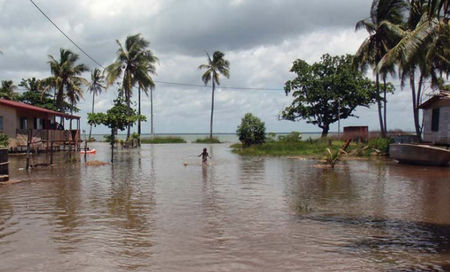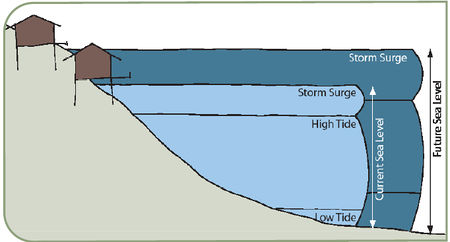Group M - Collaborative Climate Adaption Project
| Area | Torres Strait Islands | |
| Place | Iama Island (photo source: [9]) | |
| Country | Australia | |
| Topic | Sea level rise | |
| Author(s) | James Nash, Aura Istrate, Janice Thien | |

| ||
|
| ||
Rationale: Why have you selected this case study area?
- Please summarise:- e.g. previous experience, is it your everyday environment?, specific vulnerability, previous research being done etc.
We have selected this area out of our concern for those who will feel the affects of climate change first, and are representative of those who may endure the most significant impacts of climate change and sea level rise. For our project focus, we have selected an island known as Iama or Yam island. It is a part of the Torres Strait, an archipelago of islands between the Northern tip of Australia and Papua New Guinea. Politically, the islands are a part of Australia, however they are culturally distinct being a traditional Pacific Islander culture, with strong links to the traditional cultures of northern Australia and Papua New Guinea. The islanders have a specific vulnerability to climate change being a strongly sea based culture and living very much between the sea and the land. Subtle changes in sea levels and oceanic conditions (such as acidification) will have large and far reaching impacts into the islanders life, cultural orientation and livelihoods that will only become more pronounced as these changes become more drastic. Climate change may also bring more severe storm conditions via larger cyclonic tropical depressions. The communities of the Torres Strait, as indigenous people of these islands, face a host of issues concerning sovereignty and ownership rights of land due to Australian Government Policy. In addition Torres Strait Community members are significantly affected by conditions of Diabeties and Heart Disease attributed to the uptake of Western dietary choices over Traditional foods. We are particularly interested in this area as a program of adaption to climate change could have a "No Regrets" approach of also improving the preexisting health and land rights policy conditions faced by islanders. There has been some significant research into the impacts of climate change on the Torres Strait, including our project focus area of Iama Island. This research is ongoing however much of the work is predominantly taken from the perspective of setting minimum building floor levels and providing engineered infrastructure such as Sea Walls. Whilst these are significant foundations, we believe an approach from Landscape Architecture that considers settlement patterns, cultural and physical wellbeing will provide a more thorough approach towards a continuing, resilient Torres Strait Island Culture. Members of our group have had experience in strategising for Sea level rise and local experience of working in the Torres Strait.
Authors' perspectives
- What theoretical or professional perspective do you bring to the case study?
We will bring the perspective of cultural inclusiveness. We believe that the best way to work with cultures older than our own is to ask, listen, observe, learn- be guided by cultural knowledge, and then propose ideas. We will seek to understand existing regionally specific research into the effects of climate change in the Torres Strait, both widely, and on our specific project location. We will also seek to gain as much traditional knowledge about food production and harvesting technologies, transport patterns and navigation, settlement patterns and building technologies, and traditional systems of organising and local governance. We understand that much harm and damage has occured in Australian Indigenous communities through well intentioned, yet misguided development projects and we aim to take a different approach- allowing community cultural based patterns take precedence over proposals from architectural, engineering or policy based development. We believe Proposals through Landscape Architectural based practice may meet the challenge of collaborating between the adaption imperatives of new climate science and the traditional ways and context of islander culture.
Landscape and/or urban context
- Biogeography, land use patterns, cultural features, overall character, history and dynamics
- ratio of green/blue and sealed/built-up areas
The Torres Strait islands (TSI) were formed through mostly volcanic activity that formed the original landscapes of Northern Australia and Papua New Guinea (PNG). The Islands were originally a land bridge between PNG and Australia and over time, from erosive pressures of oceanic tidal currents, and previous changes in Sea levels, what was land, became sea and reef. Interestingly, Torres Strait Islands has been formed most noticeably through changes in sea level rise following the last ice age. The Island communities are closely related to Melanesia and Papua New Guinean Cultures, with some influence from Northern Australian Aboriginal Culture. They are predominantly a seafaring people, with food, transport, cultural stories, trade and family groups and settlement patterns defined by relationships with the sea. The Tribal cultures of Papua New Guinea and Melanesia appear to have a dominant historical influence on cultural paradigms, however these have evolved into a distinctly regional culture based on the islands. The Torres Strait Islanders have land use patterns both in common with PNG, Pacific Islander Culture and Australian Aboriginal cultures. Food production is both agricultural and hunted or wild harvested, however much food is imported from Australia and now forms a significant part of TSI diets. Settlement patterns are based on village structures by the sea, yet temporary seasonal camps serve food harvesting purposes on either other islands or on more remote parts of settled islands. Settlement patterns now have been heavily influenced by western style housing and suburban settlement patterns, however traditional style improvised shelters for gathering and recreation continue to be constructed and decorated from both traditional and modern reused construction materials. Islands are predominantly bushland with small areas set aside amongst housing for subsistance gardening, which is now practiced less and less. Small urban clusters now occupy small village sites, with larger blocks of housing surrounding the central village areas. Social hubs tend to be around sea ports and wharfs where people launch to the sea, arrive home to meet family or spend time fishing.
The Map shows the regional island groups, which islands are occupied and the group of island (including our project location) where islands are predominantly mangrove or coral cays close to sea level.
Image credit: Rey-Lescure 2010, Image source: [1]
The Photos below are Sketches made of the islands showing the nature of the landscape and lifestyle of people. They show that the landscape is in the Dry tropics and characterised by rocky volcanic islands, and dry tropic vegetation. Rainforest environments are found only in small rocky valleys, however rainforest plants persist amongst the dominant savannah landscapes due to the monsoonal wet-dry seasonality.
The photos below show photographs of characteristic sea side social spaces made from improvised materials by the islanders.
Case study site: Iama Island
Our case study focuses specifically on Iama Island (Yam Island), located in the central group of Islands in the Torres Strait. It is a vegetated granite island with coral sand flats fringe, approximately 2.2km long by 1.5km wide, of a total area of 175 hectares.
Iama Island is characterised by three distinct landforms. The dominant landform is vegetated, steep hilly country. Another is the plateau ares on top of steep slopes which is inaccessible. The remaining is flat coastlines which are covered at some parts by dense mangroves.
The community resides at the northwestern end of the Island, of flatland with an area of 300mx300m. The flat terrain rises to 1.5 meter above sea level, and is susceptible to sea level rise. The urban area, or the village is located between the air strip and the barge ramp towards the northwestern coastline. The residential area consists of dwellings, primary school, churches, council offices and workshop, and store.
Iama Island Population Graph, Graph source:[4]
The population maintains steadily around 340 residents (174 in 1998) for the past 10 years, with a density of 198.7 persons per kilometre square. The 2006 census shows that the average age of the population is 20 years, 40.1% of the population were under 15 years old.
Employment sector distribution of Iama Island, Diagram source: [5]
The above diagram shows that of the 133 people on employment in 2006, 111 people (83%) were in Public Administration and Safety Sector. This trend is seen across the overall Torres Strait Region, from the survey done in 2006, at least 70% of employment is in the Public Administration and Safety Sector, the remaining employment proportion are mainly distributed among retail, education and training, healthcare and social assistance.
Cultural/social/political context
- Brief explanation of culture, political economy, legal framework
The Torres Strait is politically part of Australia and is the birthplace of native title law. Torres Strait Islanders are a separate people in origin, history and way of life than the mainland Australia aboriginal people. They now live in 18 communities on 17 islands. The Islanders were fishermen, hunters and agriculturalists and are fearless defenders of their territories and cultures. Each community is distinct, having their own traditions, laws and customs.
Islanders performing traditional dance, image source:[6]
Torres Strait islanders have had some contact with outside influences and traders for centuries, including Chinese, Dutch and Portuguese explorers and traders in addition to Pacific Islander traders and explorers. From settlement in the late 19th century by colonising European cultures, traditional Torres Strait Islander society was changed by the discovery of commercial quantities of pearlshell, arrival of Christian missionaries, and all islands being legally annexed to the Colony of Queensland by 1879. In the 1980s and 1990s, Eddie Mabo- A Torres Strait Islander, challenged the Australian Government in the high court of Australia over the Australian constitutional recognition of indigenous occupation of lands prior to European settlement. He succeeded in his challenge and the Australian constitution was changed to recognise Indigenous occupation. Torres Strait Islanders were the first Indigenous Australians to be granted local self-governence. Their efforts have influenced Australian laws regarding Indigenous land tenure, and they are still working on protecting their land and sea rights.
The TSRA (Torres Strait Regional Authority) is established on 1 July 1994 in response to local demands for greater autonomy, to manage their affairs based on their own island customs. The region has its own flag signifying unity and identity of the different groups of islanders.
TSRA organisational chart, image source:[7]
The existence, condition and management of the natural environment is fundamental to the livelihood of the Iama Island community, and Torres Strait Islanders in general. The natural environment includes animals, coastline, tides and storm surges, waterways and wetlands, land and soil, and bushfire. These must be part of all decisions and plans. The well being of the natural environment is crucial for community health and its close association with cultural significant activities.
Illustration: Bullet points, image, background notes
Local Climate
- What are the climatic conditions at present? Have there been extreme weather events in the near past?
- Which changes are expected? Is there any evidence?
Torres Strait Islands have tropical maritime climate, with minimal rainfall during winter months between June to October.
The Islanders’ cultures, societies and economies rely heavily on the ecosystem. In 2005 and 2006, a number of the islands were subject to king tides and had lives threatened and damage caused. Visible changes due to climate change are increased erosion, strong winds, land accretion, increasing storm frequency and rougher seas that elders have never encountered before.
These events have caused impacts on the number of turtles nesting and altered birds’migration patterns. Dugongs (sea cow) that are traditionally hunted for meat have become scarce. The locals are not certain when to plant their crops due to seasons shifting. Their lives are threatened both physically by climate change effects on the local environment, and culturally by ongoing issues of westernisation and policy and governance. How the Torres Strait islanders adapt to these changes will determine the long term survival and integrity of their culture.
King tide breaches sea wall 2009, image source:[8]
Illustration: Table or time line
Analysis of vulnerability
- If you consider these potential changes - which aspects/functions of your case study would be affected?
- Freshwater availability
- Degradation of significant cultural sites such as burial and sacred grounds, hunting and gathering places.
- Inundation and destruction towards public facilities, settlement and sewage system
- Change in coral growth/coral bleaching
- Social and economic disadvantage reduces capacity to adapt to climate change.
- In longer term, some islands may disappear completely or lose large tract of land, forcing relocation and dispossession
- The emergence of internally displaced people (refugees within national borders) within Torres Strait. This may contribute to population pressures on islands where habitation continues.
- Longer term cultural challenges around food production may be exacerbated by climate change.
Illustration: Map/diagram/sketches/photos/background notes
Proposals for Climate Change Adaption
- How could your case study area become more resilient to climate change?
- Which measures would need to be taken to adapt to the new situation?
- How could you assure sustainability of these measures?
- Please describe 2-3 measures
Proposals for Climate Change Mitigation
- Which measures would need to be taken to reduce greenhouse gas emissions and other drivers of climate change within your case study area?
- How could you assure sustainability of these measures?
- Please describe 2-3 measures
Your scenario
- How will this area look like in 2060?
- Please forecast one potential future development taking climate change into account
Illustration: Map/diagram/sketches photos and background notes
What can be generalized from this case study?
- Are there any important theoretical insights?
- Which research questions does it generate?
- Short statement plus background notes
Presentation Slides
- Addnewimagename.jpg
Slide One
- Addnewimagename.jpg
Slide Two
- Addnewimagename.jpg
Slide Three
Image Gallery
- Yourimage.jpg
your image text
- Yourimage.jpg
your image text
- Yourimage.jpg
your image text
- Yourimage.jpg
your image text
- Yourimage.jpg
your image text
- Yourimage.jpg
your image text
- Yourimage.jpg
your image text
- Yourimage.jpg
your image text
References
Please add literature, documentations and weblinks
TSRA (2010). Torres Strait Climate Change Strategy 2010–2013. Report prepared by the Environmental Management Program, Torres Strait Regional Authority, May 2010
About categories: You can add more categories with this tag: "", add your categories
![Image credit: Rey-Lescure 2010, Image source: [1]](/images/thumb/9/9a/Annika_torres-strait-map11.png/400px-Annika_torres-strait-map11.png)

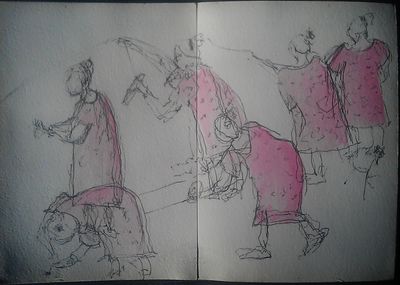

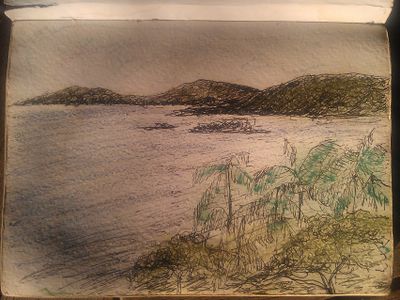
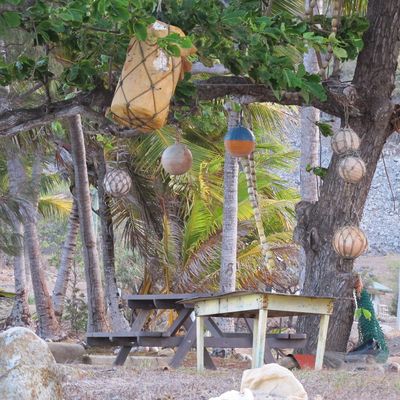

![Iama Island satellite view, image source: [2]](/images/thumb/2/29/Iama_Island_by_Conics_copy.jpg/500px-Iama_Island_by_Conics_copy.jpg)
![Iama Island Village, image source: [3]](/images/thumb/0/0b/Iama_village_copy.jpg/500px-Iama_village_copy.jpg)
![Iama Island Population Graph, Graph source:[4]](/images/thumb/9/92/Popgraph.png/400px-Popgraph.png)
![Employment sector distribution of Iama Island, Diagram source: [5]](/images/thumb/5/5d/Iama_employment.jpg/400px-Iama_employment.jpg)
![Islanders performing traditional dance, image source:[6]](/images/thumb/f/fb/Islanders_performing.jpg/300px-Islanders_performing.jpg)
![TSRA organisational chart, image source:[7]](/images/0/04/TSRA_org_chart.png)
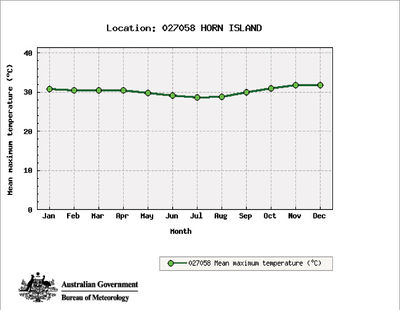
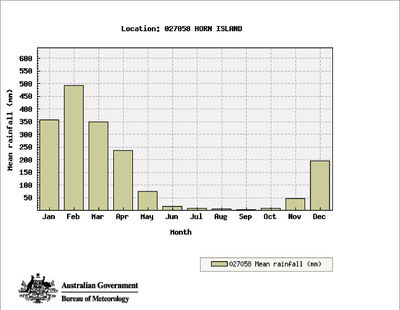
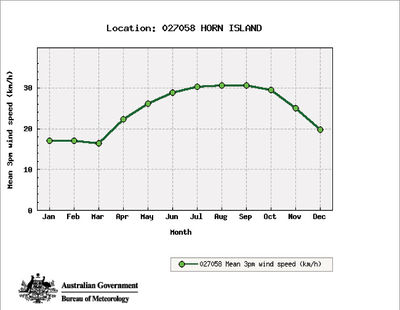
![King tide breaches sea wall 2009, image source:[8]](/images/thumb/c/cc/King_tide.jpg/300px-King_tide.jpg)
